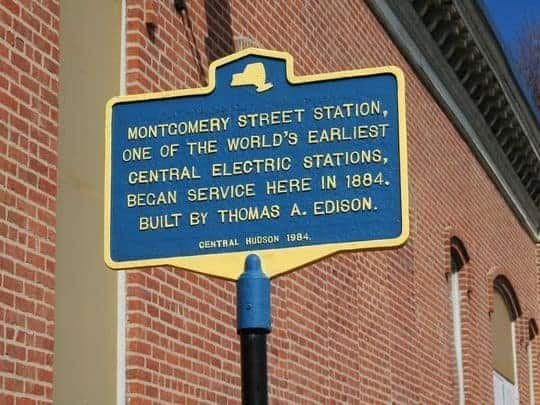On March 31, 1884, the then Village of Newburgh became the second municipality in New York to receive electricity. The power originated at a generating plant put in place by Thomas Edison that was built at a cost of $41,000.
A year prior, Edison oversaw the construction of the Pearl Street Station in lower Manhattan, the first central power plant in the country. It provided electricity for 1 square mile and had a 10,000-light capacity.
In spring 1883, Edison established a new enterprise called the Thomas A. Edison Construction Department. The company’s focus was to promote and install central power stations in smaller cities and towns.
The company installed stations in Pennsylvania, Ohio, Massachusetts and a few other locales before turning over the business to the Edison Electric Light Company. One of the ways they tried to install a power station was to interest local investors to fund it.
While Edison was involved in all the engineering plans and negotiating for the early plants, employees of the Edison Illuminating Company did the actual work. He traveled to Newburgh by train to assess the work on a regular basis.
“Thomas Edison maintained a residence in New York City and took the New York Central Railroad’s Hudson Line to get to Beacon; he then took the ferry across to Newburgh,” said Paul Israel, Ph.D. and director of the Thomas A. Edison Papers archive at Rutgers University in New Jersey. “During his projects he would stay in Manhattan, going home to Menlo Park, New Jersey on weekends and during summer months.”
Prior to the construction of the main generator plant in Newburgh the Edison Isolating Company installed two smaller plants that enabled the Orange County Woolen Mill and the Newburgh Woolen Mill to operate with electric power.
“John Taylor established the Newburgh Woolen Mill and he had a salesroom and warehouse at 542 Pearl St. in New York City,” Israel said. “That’s likely how Edison learned about the mills in Newburgh.”

The 1880s was a time of great growth and industry in Newburgh with multiple mills operating in the southwest section of the village. Mill owners foresaw the benefits of having the isolated plants installed at their site in order to run their operation with electric power.
Following a visit by village officials to review the electric-powered mills, they came away very impressed. After discussing the potential of an expanded project, they decided to contact the Edison Company to take a look at the potential of electrifying the entire community.
“Edison visited Moses Belknap, who was then treasurer of the Newburgh National Bank,” said City of Newburgh historian Mary McTamaney. “He’s the one who put in the core financing for the project to move forward.”
Other investors in Newburgh started to become interested in the project and its financial opportunities.
“One of Edison’s people visited Warren Delano (Eleanor Roosevelt’s father), who’d expressed an interest in investing in the company,” Israel said. “After generating investors, Edison sent a canvasser to the village to determine where they might put a station and what it might cost.”
Estimates were eventually submitted and a month later they proceeded with the project.
“While Edison returned to Manhattan at night after visiting the project to assess its progress, his assistant engineers who oversaw the day-to-day operation stayed in Newburgh at the United States Hotel on Front Street,” McTamaney said.
Belknap was a congregant of First Presbyterian Church (now Calvary Presbyterian Church) on the northwest corner of South and Grand streets. It was through him that the Edison team became familiar with the church and Belknap convinced them to electrify the church while they were there.
It became the first church in the state to have electric power.
The Newburgh station provided a 1,600-light capacity. It still stands at 59-69 Montgomery St. No longer a generator facility it is now used by Central Hudson as a switching station, starting in 1984.
“Dateline” appears Wednesdays in the Poughkeepsie Journal. To suggest a topic, email Anthony Musso at railcommute@gmail.com
